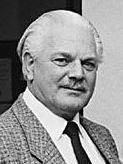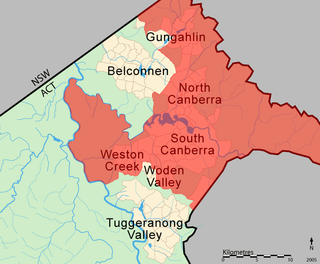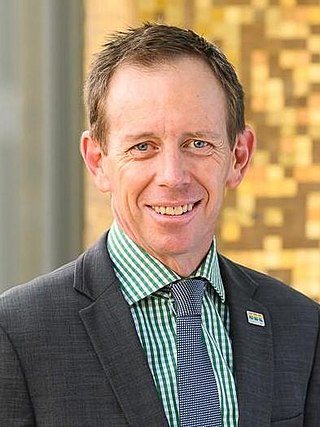
The Country Liberal Party of the Northern Territory (CLP), commonly known as the Country Liberals, is a centre-right political party in Australia's Northern Territory. In local politics, it operates in a two-party system with the Australian Labor Party (ALP). It also contests federal elections as an affiliate of the Liberal Party of Australia and National Party of Australia, the two partners in the federal coalition.
The Australia Party was a minor political party established initially in 1966 as the Liberal Reform Group. As the Australia Party, it became influential, particularly in the landmark 1972 federal election when its preferences assisted the Australian Labor Party to victory—ending 23 years of Liberal/Country Coalition government.
The premiers and chief ministers of the Australian states and territories are the heads of the executive governments in the six states and two self-governing territories of Australia. They perform the same function at the state and territory level as the Prime Minister of Australia performs at the national level. The King of Australia and the state governors are the formal repositories of executive power; however, in practice they act only on the advice of state premiers and ministers except in extreme circumstances, such as a constitutional crisis.

Gary John Joseph Humphries is a Deputy President of the Administrative Appeals Tribunal. He was a member of the Australian Senate representing the Australian Capital Territory for the Liberal Party of Australia from 2003 to 2013. He was the Chief Minister of the Australian Capital Territory from 2000 to 2001; and was elected to the first parliament of the Australian Capital Territory, in 1989, later representing the Molonglo electorate until 2003.
Rosemary Follett is an Australian former politician who was the first Chief Minister of Australian Capital Territory, serving in 1989 and again between 1991 and 1995. She was the first woman to become head of government in an Australian state or territory.
Residents Rally was an Australian political party, with four candidates elected to the first Australian Capital Territory Legislative Assembly at the 1989 Australian Capital Territory general election. Residents Rally were led by Canberra human rights barrister and lawyer, Bernard Collaery. Collaery defined the party as "a community-based urban green party". The Rally formed a coalition with the Liberal Party, led by Trevor Kaine, in late 1989. However, this fractious Alliance was to last for only two years before collapsing. The Rally was unsuccessful in retaining any seats at the 1992 ACT general election.

Brendan Michael Smyth is an Australian former politician, who was a member of the Australian Capital Territory Legislative Assembly representing the electorate of Brindabella for the Liberal Party from 1998 until 2016. From 2002 to 2006 Smyth was the ACT Leader of the Opposition and served briefly as the Deputy Chief Minister during 2000 and 2001. He has held the ACT portfolios Urban Services, Business, Tourism and the Arts, and Police and Emergency Services.

Trevor Thomas Kaine, was an Australian politician who served as Chief Minister of the Australian Capital Territory from 1989 to 1991. Kaine was elected into a multi-member single electorate in the unicameral Australian Capital Territory Legislative Assembly, from 1989 to 2001, initially as a member of the Liberal Party and later as an independent.

The 1989 Australian Capital Territory general election was held on 4 March 1989 to elect the 1st Australian Capital Territory Legislative Assembly. This was the first direct election by voters in the Australian Capital Territory (ACT) for their power legislative body.
Wayne Bruce Berry, former Australian politician, was a member of the unicameral Australian Capital Territory Legislative Assembly from 1989 to 2008, representing the electorate of Ginninderra for the Labor Party. Berry served as Deputy Chief Minister from 1991 to 1994, Leader of the Opposition from 1997 to 1998 and Speaker of the Assembly from 2001 to 2008.

The Molonglo electorate was one of the three electorates for the unicameral 17-member Australian Capital Territory Legislative Assembly between 1995 and 2016. It had seven seats, and was the largest of the three electorates in terms of population.

Allan Duncan Fraser was an Australian politician and journalist. He served as a member of the House of Representatives from 1943 to 1966 and from 1969 to 1972, representing the Division of Eden-Monaro for the Labor Party.
The Australian Capital Territory House of Assembly was the main elected representative body of the Australian Capital Territory between 1975 and 1986, during which time preparation began for the granting of self-government to the Territory. The Assembly had a largely advisory role, with most of the power over the Territory being in the hands of the relevant federal minister.

Shane Stephen Rattenbury, is the Attorney-General of the ACT and former Speaker of the ACT Legislative Assembly, and a member of the multi-member district unicameral Australian Capital Territory Legislative Assembly representing the electorate of Molonglo from 2008 to 2016 and the electorate of Kurrajong since 2016 for the ACT Greens. He was the first Speaker in any Parliament in the world representing a Green political party.

Meredith Hunter is an Australian former politician who was a member of the multi-member unicameral Australian Capital Territory Legislative Assembly representing the electorate of Ginninderra for the ACT Greens from 2008 to 2012. She was also the Parliamentary Convenor of the ACT Greens.
Andrew Whitecross was an Australian politician and a member of the Australian Capital Territory Legislative Assembly from 1995-1998, elected to the multi-member electorate of Brindabella for the Labor Party. Whitecross was elected the third ACT Legislative Assembly at the 1995 general election as a Labor member. He succeeded former Chief Minister Rosemary Follett as Leader of the Opposition in March 1996, and continued in that position until his replacement by Wayne Berry in August 1997. He recontested the seat at the 1998 general election, but was unsuccessful.
Ellnor Judith Grassby, néeLouez, a former Australian politician, was a member of the multi-member single constituency unicameral Australian Capital Territory Legislative Assembly, representing the Labor Party between 1989 and 1995. Grassby served as Minister for Housing and Urban Services in the First Follett Ministry.

A general election for the Australian Capital Territory Legislative Assembly was held on Saturday, 15 October 2016.
Gordon John Walsh was an Australian politician for the Labor Party.

The 1974 Australian Capital Territory general election was held on 28 September 1974 to elect all 18 members of the Legislative Assembly, the main elected representative body of the Australian Capital Territory (ACT). This was the first election for the Assembly, replacing the Advisory Council, although elected members did not start sitting until 1975.










